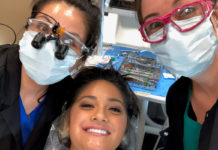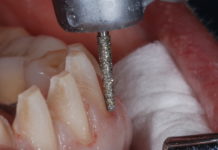
Have you ever had to call 911 for assistance or had an ambulance come to your office? With the significant increase of an aging population (and many of them with polypharmacy), your chance of encountering a medical emergency in the practice is significant. Are you and your team ready? Do you have a practice protocol?
With the significant increase of an aging population, your chance of encountering a medical emergency in the practice is significant.
Office Emergency Protocol
Once or twice a year, schedule an office training session. This session should include the following:
- Discuss team assignments—clearly identify who will do what in an emergency.
- Designate who will call 911, when they will do it, and what they will say.
- Designate a record-keeper. This person should document times for every part of the event, the medications used, and the dosages. This person should also document the patient’s vital signs.
- Verify that the office emergency kit and AED (automated external defibrillator) is up to date. Know what is in your kit, and how and when to use it.
- Decide who will assist the doctor with the event. During a high-stress medical emergency, effective communication is imperative.
Assessing the Patient
The most effective way to prevent medical emergencies is with good patient assessment. This should include a detailed review of the patient’s medical history, both past, and present. The history should include the patient’s medications—both prescription and over-the-counter (OTC). It is the dental provider’s responsibility to understand the possible issues as a result of a patient’s medication list.
During an emergency, documentation of the patient’s vital signs must be obtained. This should include blood pressure, pulse, respiration rate, height, weight, and temperature. Any allergies to medications must be discussed. The patient needs to review their medical history, sign it, and verify its accuracy.
Your office should have proper emergency equipment including, but not limited to, oxygen, and equipment to take vital signs. Emergency medications should include epinephrine, Benadryl, ammonia inhalant, aspirin, albuterol inhaler, glucose paste, nitroglycerin, and Decadron.
I document the patient’s ASA physical status classification. At every appointment, verify that there are no changes in the patient’s medical history or medications. At a minimum, a pre-treatment blood pressure reading should be obtained. Personally, I pay close attention to each patient’s gait, breathing, and BMI.
Your office should have proper emergency equipment including, but not limited to, oxygen, and equipment to take vital signs. Emergency medications should include epinephrine, Benadryl, ammonia inhalant, aspirin, albuterol inhaler, glucose paste, nitroglycerin, and Decadron.
Common Emergencies
- Syncope is the most common office emergency—particularly among young, healthy, fearful patients. It happens more often with males than with females. It’s usually preceded by a prodromal: diaphoresis, pallor, nausea, and possible seizure-like activity. Treatment of any potential emergency should be started by checking the A,B,C (airway, breathing, circulation). Position the syncope patient in a Trendelenburg position. Start their oxygen at 4 to 8 liters/minute. Monitor the patient’s vital signs. Put a cold compress on the patient’s forehead or on the back of the neck. Throughout the emergency, comfort and reassure the patient. Oftentimes, patients are embarrassed. Decide whether to reschedule or continue the procedure. If the patient doesn’t recover fairly rapidly, call 911.
- Angina is often identified by dull mid-chest pain or heaviness in the chest. If a patient complains of these pains, sit the patient upright and start oxygen. If the patient has their own nitroglycerin, they can take it. If you administer the nitroglycerin, give .4mg every 5 minutes with a maximum of three doses. Constantly monitor and document vital signs.
- Heart disease is the leading cause of death in the United States. All of your team members should be trained in CPR/BLS and AED use. Myocardial infarction will present with a complaint of crushing chest pain, often radiating to the left arm, shoulder, or mandible. Nausea, vomiting, dizziness, abnormal pulse, shortness of breath, and disorientation may follow. Treatment should start immediately. Activate EMS (911) and remember to check the A, B, C’s. Oxygen should be administered via a mask with maximum flow. Consider sublingual nitroglycerin. Give the patient an aspirin. Position the patient where they are most comfortable. Have the AED ready for use. Start CPR with loss of consciousness. Constantly monitor and document vital signs.
- Airway obstruction is not uncommon in a dental office. Treatment should begin with inspection and suctioning of the oropharynx. Use gauze to retract the tongue. Place the patient in a supine position and attempt to ventilate with a chin lift procedure. The Heimlich maneuver should be considered. If your patient swallows a foreign object, send him or her to Urgent Care for a chest X-ray and KUB X-ray to identify the location.
- Asthma is a common respiratory condition. Always encourage your patients to bring their inhalers with them to appointments. If a patient develops labored breathing with difficult expiration, cyanosis, wheezing, chest tightness, or shortness of breath, treat with a bronchodilator and supplement with oxygen. Sit patient upright, remember to check the A, B, C’s.
- Anaphylaxis will likely be identified when the patient experiences difficulty breathing, wheezing, hypotension, tachycardia, hives/welts, and angioedema. Treatment should begin with removal of the allergen if known. Activate EMS (911). Remember the A, B, C’s. An epinephrine pen is the quickest way to administer this drug—an adult dose is .3mg every 20 minutes with a maximum of three doses and a child’s dose is .15mg. An Albuterol inhaler may be helpful. Administer Benadryl (50mg) for adults and 25mg for children. An 8mg injection of Decadron in adults or 4mg in children may be helpful also.
- Stroke can be obstructive ischemia (80 percent of cases) or hemorrhagic (20 percent of cases). Usually, the patient will complain of weakness or numbness on one side. A headache may develop. The patient may experience confusion, difficulty speaking, visual issues, or loss of balance. If you think your patient is suffering from a stroke, time is critical. Call 911 immediately. If proper treatment is administered within three hours, there is a 30 percent increase in the patient having no residual issues.
- Hyperventilation develops with a decrease in CO2 and an increase in the blood pH. This is almost always caused by anxiety. The patient may complain of tightness in their chest and tingling in the hands or feet. Sit the patient up. Do not administer oxygen. Instead have the patient take big, deep breaths into a paper bag.
- In the event of a seizure, clear the area around the patient. Grand mal seizures are the most common in the dental setting. Discontinue treatment immediately and monitor the patient. Make every effort to protect the patient, but don’t try to restrain the patient. Be prepared with suction and always reassure the patient. If the seizure continues for more than five minutes, activate EMS.
- When treating a diabetic patient, always ask them when they last ate and if they took their meds appropriately. It is a good idea to have a portable glucose monitor in your office. A simple treatment for hypoglycemia is fruit juice. If a hypoglycemic patient becomes unconscious, place them supine with their legs slightly elevated. Administer glucagon and activate EMS.
If you think your patient is suffering from a stroke, time is critical. Call 911 immediately. If proper treatment is administered within three hours, there is a 30 percent increase in the patient having no residual issues.
Most practitioners will experience a medical emergency at some point in their career. Being prepared for an emergency will help reduce your personal stress and make your office much safer for your patients. Management of the medical emergency is a team approach, and every team member needs to be comfortable in their role.









